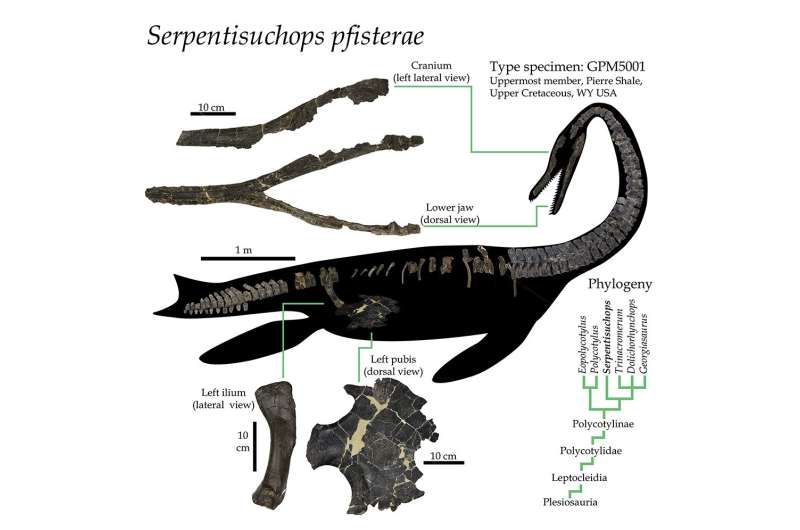September 27, 2022 report
Plesiosaur unearthed in 1995 found to have been long-necked marine reptile

A team of researchers studying a plesiosaur found at a dig site in Wyoming identified it as a long-necked marine reptile. In their paper published in the journal iScience, the group outlines their findings and where the specimen fits in with others from its time.
A team of paleontologists discovered the plesiosaur fossil remains back in 1995 and brought it to the Glenrock Paleontological Museum, where it was studied on and off over the years. But it was not given a serious study until recently. The researchers began their work by noting that plesiosaurs have generally been found in two main varieties, those with long, snake-like necks topped by a small head, or those with a short neck and a head with a long jaw reminiscent of a crocodile. The new one did not fit the pattern—it had a long neck and a croc-like mouth. It was named Serpentisuchops pfisterae, which, the researchers note, roughly translates to "creature with a snaky crocface."
Measurements showed the creature to be approximately 7 meters long. The researchers estimated that they had about 35% of the creature represented by the fossils. They also noted that it was well preserved—the only parts missing were those related to its legs and feet, which are believed to have been paddle-shaped. The researchers noted it had long, conical-shaped teeth, which were smooth and not meant for cutting. This, the researchers note, suggests the creature captured and ate small prey that it could skewer with its sharp teeth. They further suggest that it likely undulated as it moved through the water, moving its neck back and forth and then snapping its jaws shut to grab and swallow fish or other small sea creatures.
The specimen was dated to the Mesozoic—it was found in shale dated to approximately 66 to 101 million years ago and was just one of many types of plesiosaur, which were a group of marine diapsids. The researchers also noted that its wide cervical neural spines suggested it had large epaxial muscles that allowed for quick movement of its head and neck.
More information: Walter Scott Persons et al, A long-snouted and long-necked polycotylid plesiosaur from the Late Cretaceous of North America, iScience (2022). DOI: 10.1016/j.isci.2022.105033
Journal information: iScience
© 2022 Science X Network





















